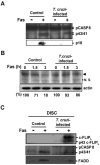Trypanosoma cruzi posttranscriptionally up-regulates and exploits cellular FLIP for inhibition of death-inducing signal
- PMID: 15917295
- PMCID: PMC1182294
- DOI: 10.1091/mbc.e04-12-1051
Trypanosoma cruzi posttranscriptionally up-regulates and exploits cellular FLIP for inhibition of death-inducing signal
Abstract
Intracellular persistence of the protozoan parasite, Trypanosoma cruzi, is an aggravating cause of Chagas' disease, involving that the protozoan infection specifically inhibits death receptor-mediated apoptosis of host cells. Here we demonstrate that the parasite dramatically up-regulates cellular FLICE inhibitory protein (c-FLIP), the only known mammalian inhibitor specific for death receptor signaling, in infected cells by an unusual, posttranscriptional stabilization of the short-lived protein. We also show that c-FLIP is accumulated in T. cruzi-infected mouse heart muscle cells in vivo. Stimulation of death receptor Fas in infected cells induces recruitment of c-FLIP to block the procaspase-8 activation at the most upstream caspase cascade. c-FLIP knock-down with a small interfering RNA significantly restores Fas-mediated apoptosis in infected cells. Taken together, our findings indicate that T. cruzi posttranscriptionally up-regulates and exploits host c-FLIP for the inhibition of death-inducing signal, a mechanism that may allow parasites to persist in host cells.
Figures





Similar articles
-
A role for caspase-8 and c-FLIPL in proliferation and cell-cycle progression of primary hepatocytes.Carcinogenesis. 2005 Dec;26(12):2086-94. doi: 10.1093/carcin/bgi187. Epub 2005 Jul 20. Carcinogenesis. 2005. PMID: 16033771
-
Rapid up-regulation of c-FLIP expression by BCR signaling through the PI3K/Akt pathway inhibits simultaneously induced Fas-mediated apoptosis in murine B lymphocytes.Immunol Lett. 2007 Mar 15;109(1):36-46. doi: 10.1016/j.imlet.2006.12.009. Epub 2007 Jan 22. Immunol Lett. 2007. PMID: 17275920
-
Cellular FLICE-inhibitory protein splice variants inhibit different steps of caspase-8 activation at the CD95 death-inducing signaling complex.J Biol Chem. 2001 Jun 8;276(23):20633-40. doi: 10.1074/jbc.M101780200. Epub 2001 Mar 5. J Biol Chem. 2001. PMID: 11279218
-
The caspase-8 modulator c-FLIP.Crit Rev Immunol. 2005;25(1):31-58. doi: 10.1615/critrevimmunol.v25.i1.30. Crit Rev Immunol. 2005. PMID: 15833082 Review.
-
The role of cellular FLICE inhibitory protein (c-FLIP) in the pathogenesis and treatment of cancer.Expert Opin Ther Targets. 2006 Feb;10(1):27-35. doi: 10.1517/14728222.10.1.27. Expert Opin Ther Targets. 2006. PMID: 16441226 Review.
Cited by
-
Death receptor-associated pro-apoptotic signaling in aged skeletal muscle.Apoptosis. 2006 Dec;11(12):2115-26. doi: 10.1007/s10495-006-0194-6. Apoptosis. 2006. PMID: 17051337 Free PMC article.
-
Trypanosoma cruzi, Chagas disease and cancer: putting together the pieces of a complex puzzle.Front Cell Dev Biol. 2023 Dec 21;11:1260423. doi: 10.3389/fcell.2023.1260423. eCollection 2023. Front Cell Dev Biol. 2023. PMID: 38188016 Free PMC article. Review.
-
Toll-like receptor-2 and interleukin-6 mediate cardiomyocyte protection from apoptosis during Trypanosoma cruzi murine infection.Med Microbiol Immunol. 2012 May;201(2):145-55. doi: 10.1007/s00430-011-0216-z. Epub 2011 Oct 9. Med Microbiol Immunol. 2012. PMID: 21984337
-
New Insights into the Immunobiology of Mononuclear Phagocytic Cells and Their Relevance to the Pathogenesis of Cardiovascular Diseases.Front Immunol. 2018 Jan 9;8:1921. doi: 10.3389/fimmu.2017.01921. eCollection 2017. Front Immunol. 2018. PMID: 29375564 Free PMC article. Review.
-
Transcriptome profile of Trypanosoma cruzi-infected cells: simultaneous up- and down-regulation of proliferation inhibitors and promoters.Parasitol Res. 2008 Mar;102(4):715-22. doi: 10.1007/s00436-007-0819-x. Epub 2007 Dec 5. Parasitol Res. 2008. PMID: 18058129
References
-
- Benedict, C. A., Norris, P. S., and Ware, C. F. (2002). To kill or be killed: viral evasion of apoptosis. Nat. Immunol. 3, 1013–1018. - PubMed
-
- Beverley, S. M. (1996). Hijacking the cell: parasites in the driver's seat. Cell 87, 787–789. - PubMed
-
- Brener, Z. (1973). Biology of Trypanosoma cruzi. Annu. Rev. Microbiol. 27, 347–382. - PubMed
Publication types
MeSH terms
Substances
LinkOut - more resources
Full Text Sources
Research Materials
Miscellaneous

